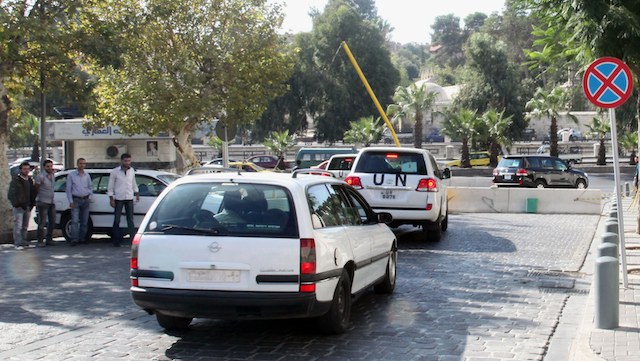SUMMARY
This is AI generated summarization, which may have errors. For context, always refer to the full article.

THE HAGUE, The Netherlands – The world’s chemical weapons watchdog has called for temporary truces to meet tight disarmament deadlines in Syria, where fresh bloodshed served as a deadly reminder of the mission’s difficulties.
“I think if some temporary ceasefires can be established, I think those targets could be reached,” Organisation for the Prohibition of Chemical Weapons chief Ahmet Uzumcu told journalists in The Hague.
The OPCW has been charged with dismantling Syria’s chemical arsenal and facilities by mid-2014 under the terms of a UN Security Council resolution drawn up after deadly nerve gas attacks in August.
Uzumcu said during a rare public briefing on the state of Syria’s disarmament that the timeline “is extremely tight”, with 20 sites to be visited in the coming weeks.
He denied however that the deadlines, including the destruction of all production facilities by November 1, were unrealistic. “Much depends on the situation on the ground, that’s why we have urged all parties in Syria to be cooperative,” Uzumcu said. “The elimination is in the interest of all.”
The OPCW said on Tuesday, October 8, it was sending a second wave of inspectors to bolster the disarmament mission in the war-ravaged nation. Uzumcu said that another 12 experts were being sent to Damascus.
Syria has won rare international praise for its cooperation with the chemical disarmament mission, deployed in Damascus since October 1.
Inspectors have already visited one chemical site in Syria and are visiting another near Damascus on Wednesday, October 9. A team of around 30 OPCW arms experts and UN logistics and security personnel are on the ground and have started to destroy weapons production facilities, with footage of their work broadcast on Syrian television.
Syria has already made a declaration of its weapons facilities, and the UN resolution set a November 1 deadline for the eradication of production and chemical mixing facilities.
Speaking at the same press conference, Uzumcu’s political advisor Malik Ellahi said “at the moment there are certain sites that are located in areas which are dangerous.”
Ellahi added that most sites to be inspected at this stage were in Syrian government-controlled areas. “You can’t treat security as a static concern. It’s a dynamic and fluid situation. That’s why we work very closely with the United Nations.”

Snipers shot at UN inspectors in August as they travelled to the scene of a suspected poison gas attack at Ghouta east of Damascus in which hundreds were killed.
In ongoing fighting, Syrian rebels seized a guard post on the Jordanian border on Wednesday after a month of fierce fighting, the Syrian Observatory for Human Rights said.
“Rebel fighters took control of the Hajanah border battalion post near the city of Daraa after laying siege to it for two months and fierce clashes around it lasting a month,” the NGO said.
Tensions rise in Golan Heights
With its capture, opposition forces now control a ribbon of territory along the border from outside Daraa to the edge of the Israeli-occupied Golan Heights, where an Israeli soldier was lightly wounded by stray fire.
Another Israeli soldier was left in shock after two mortar shells landed near them in the Golan. An army spokeswoman said Israeli forces returned fire.
Tensions have risen in the Golan Heights, which Israel captured from Syria in the 1967 Six-Day War, with Israel’s armed forces chief on Tuesday predicting that the strategic plateau could at any moment erupt into serious violence.
Elsewhere, the Observatory reported fierce fighting in Damascus province between rebels and troops backed by pro-regime militias and fighters from Lebanon’s Shiite Muslim movement Hezbollah.
The clashes were taking place around south of the capital, in the areas of Husseiniyah, Al-Thiyabiyeh and Bouaydah, the NGO said.
Husseiniyah and Al-Thiyabiyeh are located near the Shiite pilgrimage site of Sayyida Zeinab. Clashes have been reported in the area for months and fighters from Hezbollah, which backs Assad’s regime, have been dispatched to protect the site.
The Observatory said the latest round of fighting had left “at least 22 people, the majority of them rebels, including a commander” dead.
At the same time, it said “dozens” of regime forces were killed.
Confirming Syria’s status as the most dangerous place in the world for journalists, France said on Wednesday that reporter Nicolas Henin and photographer Pierre Torres had been abducted in Syria in June, bringing to at least four the number of French nationals held in Syria.
And with no sign of an end to the conflict in sight, a top European Union official warned of a “massive influx” of Syrian refugees.
More than two million Syrians have fled their country to seek refuge mainly in Lebanon, Jordan and Turkey, and the number could swell to 3.5 million by year’s end, internal markets commissioner Michel Barnier warned. – Rappler.com
FULL COVERAGE: The Crisis in Syria
Add a comment
How does this make you feel?
There are no comments yet. Add your comment to start the conversation.